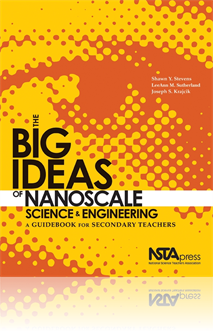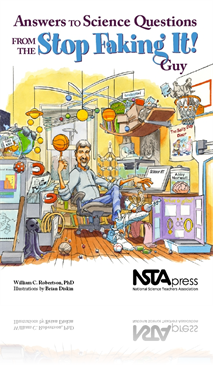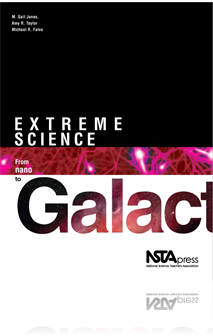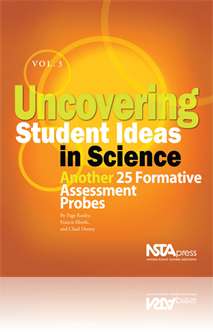All Book Chapters
Book Chapter
Science, Technology, and Society
The advancement of science involves developing explanations for how and why things work and using technology to apply that knowledge to meet objectives, solve problems, or answer questions of societal interest. Because nanotechnology is an emergent s...
Book Chapter
As our society becomes more dependent on nanoscale science and engineering (NSE) technologies, children globally will grow up in a world in which they will need to apply NSE ideas. Without a firm understanding of NSE big ideas, young people will not ...
Book Chapter
Applying the Foundational Science Content
The four big ideas discussed in Chapter 1 provide the foundation for developing understanding of nanoscale phenomena. Two additional big ideas—Size-Dependent Properties and Self-Assembly—require learners to apply concepts from some or all of the ...
Book Chapter
The six big ideas of NSE discussed so far have been directly related to science content necessary for understanding nanoscale phenomena. The two big ideas in this chapter—Tools and Instrumentation and Models and Simulations—are critical for advan...
Book Chapter
The final big idea of NSE is different from the others. It describes the natures of science and technology and how society affects and is affected by scientific and technological advancement. Thus the Science, Technology, and Society big idea is link...
Book Chapter
Concepts relating to size and scale (and geometry) affect students’ abilities to build understanding in a variety of scientific disciplines, including developing conceptual understanding of nanoscale phenomena. Ideally, concepts related to size and...
Book Chapter
Materials consist of building blocks that often form a hierarchy of structures. Atoms interact with each other to form molecules. The next higher level of organization involves atoms, molecules, or nanoscale structures interacting with each other to ...
Book Chapter
The content related to forces and interactions is important to most science disciplines. While chemistry is the most obvious place to introduce these ideas, it is important to connect aspects of this big idea to phenomena in biology, physics, and Ear...
Book Chapter
Quantum theory is an extremely advanced and complicated model. However, some aspects are accessible and useful for building an appreciation and understanding of the novel properties exhibited by matter at the nanoscale. In this chapter, the authors p...
Book Chapter
The properties of matter can change with scale. In particular, during the transition between the bulk material and individual atoms or molecules, a material often exhibits unexpected properties that lead to new functionality. This transition generall...
Book Chapter
Is It Possible to Turn Coal Into Diamonds?
How cool would it be to be Lois Lane? Anytime she wants a diamond, she just has Superman use his super strength to squeeze a lump of coal. But is this really possible? Using a high enough temperature and enough pressure, can you turn coal into diamo...
Book Chapter
Scale is one of the big ideas that cross the science domains. Whether one is talking about the weight of a blue whale, the size of a galaxy or a molecule, or the age of a mountain range, scale is an essential tool in understanding the universe in a s...
Book Chapter
The purpose of this assessment probe is to elicit students’ ideas about thermal expansion. It is designed to find out whether students attribute expansion of the space between molecules to the rise of the liquid in a thermometer. Elementary school ...
Book Chapter
The purpose of this assessment probe is to elicit students’ ideas about the mass of a gas. It is designed to reveal whether students recognize that an uninflated balloon will increase in mass when inflated with a gas, even though the balloon intuit...
Book Chapter
The purpose of this assessment probe is to elicit students’ ideas about conservation of matter. It is designed to reveal whether students recognize that the mass of a warm gas in a closed system is the same after it has been cooled, even though the...
Book Chapter
The purpose of this assessment probe is to elicit students’ ideas about reflection of light. It can be used to examine how students use ideas about light to explain how we see objects in a mirror. Elementary school students investigate reflection o...
Book Chapter
The purpose of this assessment probe is to elicit students’ ideas about complete circuits involving lightbulbs. It reveals whether students recognize the pathway of electricity in a complete circuit, including its path through a lightbulb, in order...
Book Chapter
The purpose of this assessment probe is to elicit students’ ideas about forces. It is designed to find out whether students recognize that balanced forces act on a stationary object. It is most appropriate for middle and high school students. Eleme...
Book Chapter
The purpose of this assessment probe is to elicit students’ ideas about circular motion. It is designed to determine whether students recognize that an object will move in a straight line unless acted upon by an outside force. Elementary students m...
Book Chapter
The purpose of this assessment probe is to elicit students’ ideas about falling objects. It is designed to find out if students think the weight or mass of an object affects how fast it falls. For elementary students investigations of the motion of...
Book Chapter
The purpose of this assessment probe is to elicit students’ ideas about the nature of science. It is designed to find out if students distinguish scientific theories from the common use of the word theory and if they understand how theories differ ...
Book Chapter
The purpose of this assessment probe is to elicit students’ ideas about scientific investigations. It is designed to find out if students recognize that scientists investigate the natural world in a variety of ways depending on the question they po...
Book Chapter
The purpose of this assessment probe is to elicit students’ ideas about hypotheses. It is designed to find out if students understand what a hypothesis is, when it is used, and how it is developed. Elementary students typically engage in inquiry to...
Book Chapter
The purpose of this assessment probe is to elicit students’ ideas about life cycles. The probe can be used to determine whether students recognize that although life cycles vary in length and developmental stages, all multicellular organisms go thr...
Book Chapter
The purpose of this assessment probe is to elicit students’ ideas about the size of cells. It can be used once students understand that all organisms are made up of cells and to determine whether students recognize how small a cell is relative to o...
Book Chapter
The purpose of this assessment probe is to elicit students’ ideas about growth. It can be used to determine whether students recognize that growth occurs as a result of cell division, which increases the number of body cells. Elementary school stud...
Book Chapter
The purpose of this assessment probe is to elicit students’ ideas about respiration. It is designed to find out whether students recognize respiration as a process that all living things use in order to obtain energy or whether they have a restrict...
Book Chapter
The purpose of this assessment probe is to elicit students’ ideas about decay and decomposers. It can be used to determine whether students recognize the need for a biological agent to break down once-living material as it uses it for energy. Eleme...
Book Chapter
The purpose of this assessment probe is to elicit students’ ideas about the cycling of matter. It can be used to determine whether students recognize that once-living matter breaks down and cycles through ecosystems without subtracting or adding ma...
Book Chapter
The purpose of this assessment probe is to elicit students’ ideas about an everyday object in the sky—clouds. It is designed to determine whether students recognize that clouds are made up of tiny droplets of water or tiny ice crystals. Elementar...
Book Chapter
Where Did the Water Come From?
The purpose of this assessment probe is to elicit students’ ideas about condensation. It is designed to determine whether students recognize that condensation comes from the water vapor in the air. Elementary students’ emphasis is on observing a...
Book Chapter
The purpose of this assessment probe is to elicit students’ ideas about precipitation. It is designed to determine whether students understand what causes the water in clouds to fall as rain. Elementary students’ emphasis should be on observing a...
Book Chapter
The purpose of this assessment probe is to elicit students’ ideas about seasons. It can be used to determine whether students recognize the effect of the Earth’s tilt on its axis and the resulting intensity of sunlight as the reason for seasons. ...
Book Chapter
The purpose of this assessment probe is to elicit students’ ideas about light and shadows. It is designed to find out students’ ideas about how shadows change throughout the day. Observing changes in shadows is a common activity for elementary sc...
Book Chapter
The purpose of this assessment probe is to elicit students’ ideas about stars. It is designed to examine students’ ideas about the location of stars in the daytime. Elementary students make observations of the day and night sky and question where...
Book Chapter
The purpose of this assessment probe is to elicit students’ ideas about solids. It is designed to reveal the macroscopic and/or microscopic properties students use to decide whether a material is a solid. Elementary school students describe the pro...
Book Chapter
This engaging lesson simultaneously involves animals, flowers, mathematical patterns, and art. Students will learn to discern between radial symmetry, bilateral symmetry, and asymmetry by observing and classifying objects, shapes, and photos and by d...
Book Chapter
Calculating the Speed of Sound
Who hasn’t seen a dramatic flash of lightning, only to hear the dramatic “crack” of thunder several seconds later? But why does the thunder reach our ears after we see the lightning? Or, why does the sound of a high-flying jet airplane passing ...
Book Chapter
Exploring the Dynamics of Temperature
Would your students like to take care of a penguin? To be a “penguinsitter,” they would have to know what conditions that bird needs to survive. One important factor would be temperature. In this activity, you will challenge student groups to pro...
Book Chapter
Observing the Effects of Acids and Bases
Combining acid/base chemistry, cell biology, and quantitative research methods, this “egg-ceptional” activity promotes a truly interdisciplinary perspective. First, students find out what effect acids and bases have on calcium-based substances su...







.jpg)